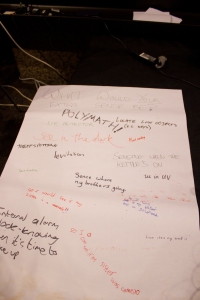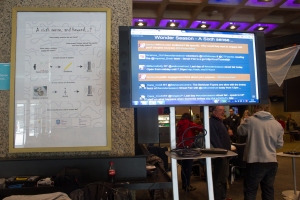New Blog…
As you probably noticed I stopped updating this blog. If you’re still interesting in reading my new posts, you can find me at medium. Thanks for all the support/comments so far.

What makes things funny?
I’m planning to write a blog post about comedy in the near future. For now, you can enjoy this interesting TED talk by Peter McGraw, one of the researchers that developed the Benign Violation Theory. You can read more about it here.
Do older adults benefit from videogames?
Brain training games claim to boost your mental skills. But while practicing a game might make you better at it, research in young people has shown it doesn’t improve how well you perform other cognitive tasks in everyday life. Now a new study suggests the case may be different for adults above the age of 60. Researchers at the University of California have designed a driving game called NeuroRacer. In this Nature Video, we see how the game can improve an older player’s short-term memory and attention, skills which decline with age.
Read the original research paper here:http://dx.doi.org/10.1038/nature12486 (from Nature)
Holding a guitar case can increase your success with women… if you’re attractive (and live in France)
I came across a fun little study published on the Psychology of Music. The experimenters designed a simple experiment to test whether music plays in role in sexual selection. To be honest, I am not sure if that was what they actually tested but I’ll let you decide on that. It seems that what they tested was whether holding a guitar case increases women’s receptivity to a courtship solicitation – if you are attractive, male and live in France. The participants were 300 young females with an estimated age between 18 and 22 years, who were walking alone in several shopping streets of a medium-sized city in France. The experiment was conducted on a sunny Saturday afternoon at the beginning of the summer period. A 20-year-old man, previously evaluated as having a high level of physical attractiveness, acted as confederate.
The participants were selected following a random assignment in which the confederate was instructed to approach the first young woman in the age group (18–22 years) who appeared alone on the pedestrian walkway. He was instructed not to select a participant according to her physical attractiveness, the way she was dressed, her height, etc. He was instructed to wait until a young woman between approximately 18 and 22 years of age passed by him in the street, and then to approach her… The confederate was instructed to approach the young women with a smile and to say, “Hello. My name’s Antoine. I just want to say that I think you’re really pretty. I have to go to work this afternoon, and I was wondering if you would give me your phone number. I’ll phone you later and we can have a drink together someplace.” According to the experimental conditions, the confederate held in his hands a black acoustic guitar case (guitar case condition), a large black sports bag (sports bag control condition), or nothing (no bag control condition). After testing 10 women in one condition, the confederate was instructed to move to another area and to select a new experimental condition according to a random distribution.
The confederate talked to 300 women in one afternoon.. Impressive. The results? In the guitar case condition, 31% (!) of the women gave their phone number to the confederate , compared to 9% in the sports bag condition and 14% in the no bag control condition. It seems that holding a guitar case is an effective strategy if you’re attractive. Holding a sports bag seems to have the opposite effect. There are many problems with this study which the authors recognise. First of all, they only used one confederate and his physical attractiveness was high. He was voted as the most good looking guy among a list of others in a previous study. As a result, it is difficult to generalise the effects to other male confederates with various attractiveness levels. It’d be interesting to see if holding a guitar case would increase women’s receptivity to a courtship solicitation by an average looking male. Also, only one instrument was manipulated in this study. Could the effect be limited to the guitar?
Reference
Giving People An Extra Sense: Some Thoughts and Many Photos from the Wonder Street Fair!
I’ve always been interested in science communication. Perhaps, because that’s how I got interested in science in the first place. Documentaries, public talks, popular science books. So, whenever I get the chance I try to give something back. No, I’m not hoping to inspire people to become scientists – there’s enough competition already (joking)! Challenging their views and making them come up with interesting questions are probably the most important things.
Taking part at the Street Wonder Fair in the first week of April during BNA 2013 was an excellent opportunity for public engagement. So you can imagine how excited I was when our project “A sixth sense and beyond” was accepted! Brains AND Barbican (if you ever visit London, you must visit this place); perfect.
Here’s a brief description of what we attempted to do:
Have you ever wanted an extra sense? How about using sonar to see in the dark, or always keeping your bearings with an internal compass? Explore the mysterious world of sensory augmentation, and decide what extra sense you would have.
(official page here)
You might be a bit disappointed to see that we didn’t really give people “a sixth sense”, but remember, this is a cognitive psychology/neuroscience blog. It did work though. It got people’s attention. Festival attendees were given the chance to experience how it feels to have an “extra sense” by wearing a hat connected to a small device which gave them an “internal compass” by indicating the direction of the magnetic north through vibration. The device was inspired by a similar gadget that was developed in the University of Osnabrück.
See a photo of the unit below:


Attendees were asked to close their eyes and point to the direction of the magnetic north following the signals from the hat. Kids were given the opportunity to play a modified version of pin the tail to the donkey game (see pic below). There was a ongoing debate whether the animal was a donkey or a giraffe – to me it’s clearly a giraffe.
It was rewarding to see both adults and children having fun with device. Here are a few pics from our last day:
We also asked the participants what would their answer be to the question ‘If you could have any extra sense, what would it be?’ and encouraged them to write it down on a board. People came up with a few interesting ideas. We’re still debating whether some of them are actually senses!
Here are some of the answers people gave:However, some of those choices promoted further discussions about the senses with various attendees.


I have some experience in public engagement (ScienceBrainwaves) but I’d never taken part in such a big event. Even though standing in front of the stall talking to people for hours for 3 consecutive days was exhausting (there were only 3 of us, so we could only take (very) short breaks), it was a fascinating experience! I’m really sorry for not having enough time to check out all the other stalls. There were so many researchers having interesting demonstrations – from knitting neurons to virtual brain surgery! Hoping I get the chance to be part of a similar event in the future.
LOL cats and Neuroscience?
I never expected to see this. Using LOL cats to describe a new study? The result is surprisingly good. Maybe I’m slightly biased because I love cats.
Here’s the abstract of the newly published (31/01) Nature paper in case you want to learn more:
Stroking of the skin produces pleasant sensations that can occur during social interactions with conspecifics, such as grooming1. Despite numerous physiological studies (reviewed in ref. 2), molecularly defined sensory neurons that detect pleasant stroking of hairy skin3, 4 in vivo have not been reported. Previously, we identified a rare population of unmyelinated sensory neurons in mice that express the G-protein-coupled receptor MRGPRB4 (refs 5, 6). These neurons exclusively innervate hairy skin with large terminal arborizations7 that resemble the receptive fields of C-tactile (CT) afferents in humans8. Unlike other molecularly defined mechanosensory C-fibre subtypes9, 10, MRGPRB4+ neurons could not be detectably activated by sensory stimulation of the skin ex vivo. Therefore, we developed a preparation for calcium imaging in the spinal projections of these neurons during stimulation of the periphery in intact mice. Here we show that MRGPRB4+ neurons are activated by massage-like stroking of hairy skin, but not by noxious punctate mechanical stimulation. By contrast, a different population of C fibres expressing MRGPRD11 was activated by pinching but not by stroking, consistent with previous physiological and behavioural data10, 12. Pharmacogenetic activation of Mrgprb4-expressing neurons in freely behaving mice promoted conditioned place preference13, indicating that such activation is positively reinforcing and/or anxiolytic. These data open the way to understanding the function of MRGPRB4 neurons during natural behaviours, and provide a general approach to the functional characterization of genetically identified subsets of somatosensory neurons in vivo.
You can read the paper here (paywall alert).
PS: LOL cats seem to be popular in academia lately. Remember the LOLcat dissertation?

Interesting TED Talks: Faith Jegede: “What I’ve learned from my autistic brothers”
Faith Jegede tells the moving and funny story of growing up with her two brothers, both autistic — and both extraordinary. In this talk from the TED Talent Search, she reminds us to pursue a life beyond what is normal.
Writer Faith Jegede draws on her experiences growing up with two autistic brothers in order to spread awareness and understanding about this increasingly common diagnosis (from TED)
I was pleasantly surprised by this. Some very interesting points about “normality” that are often forgotten by scientists/clinicians/researchers/etc.
Eye Movements and Lie Detection – Another Myth?
This is not a proper post. It is more like a long tweet. Having done a similar study last year and finding no significant results I felt I had to share this with you.
 You have probably heard that right-handed people look up to their right when they are telling a lie, while they look up to their left when they are telling the truth. Surprisingly, even though many people believe this is to be scientifically established, a quick google search comes up with no relevant peer-reviewed papers. Richard Wiseman and colleagues investigated this notion with three different studies. All three studies provided no evidence to support the notion. So it seems that the patterns of eye-movements do not aid lie detection.
You have probably heard that right-handed people look up to their right when they are telling a lie, while they look up to their left when they are telling the truth. Surprisingly, even though many people believe this is to be scientifically established, a quick google search comes up with no relevant peer-reviewed papers. Richard Wiseman and colleagues investigated this notion with three different studies. All three studies provided no evidence to support the notion. So it seems that the patterns of eye-movements do not aid lie detection.
Why did this myth survive for such a long time? Probably thanks to psychologists’ reluctance to publish negative results…
Here is the abstract:
Proponents of Neuro-Linguistic Programming (NLP) claim that certain eye-movements are reliable indicators of lying. According to this notion, a person looking up to their right suggests a lie whereas looking up to their left is indicative of truth telling. Despite widespread belief in this claim, no previous research has examined its validity. In Study 1 the eye movements of participants who were lying or telling the truth were coded, but did not match the NLP patterning. In Study 2 one group of participants were told about the NLP eye-movement hypothesis whilst a second control group were not. Both groups then undertook a lie detection test. No significant differences emerged between the two groups. Study 3 involved coding the eye movements of both liars and truth tellers taking part in high profile press conferences. Once again, no significant differences were discovered. Taken together the results of the three studies fail to support the claims of NLP. The theoretical and practical implications of these findings are discussed.
The rest of the article can be found on PLoS ONE.
Cake Is Better Than Sex: The Case of Asexuality
Recently, a “new” sexual orientation has started getting attention in the media, asexuality (or nonsexuality) (e.g., see recent article on the Metro)
 But what is asexuality? No, we are not talking about the asexual reproduction of invertebrates and other lower-level vertebrates. Unfortunately, there is only a limited number of studies on asexuality. In fact, some psychologists still doubt its existence or see it as sexual dysfunction. In the UK about 1% of the population self-identify as asexual (Bogaert, 2004). A few definitions have been given for asexuality: Storms (1980) defines asexuality as the absence of sexual orientation. This is similar to the definition given by Bogaert (2004), who describes asexuality as the lack of basic attraction towards others. The definition adopted by the largest international online community of asexual individuals, the Asexual Visibility and Education Network (AVEN) is broader than the ones mentioned above. AVEN defines asexuality as the lack of sexual attraction. A quick look at the forums at AVEN reveals that there is a great level of variability between individuals who self-identify as asexuals. Some are characterised by a lack of romantic orientation, as well as sexual attraction. Other, however, experience romantic attraction and identify as hetero-romantic (romantically attracted to people from the opposite sex), homo-romantic asexuals (romantically attracted to people from the same sex), or bi-romantic asexuals (attracted to individuals from both sexes).
But what is asexuality? No, we are not talking about the asexual reproduction of invertebrates and other lower-level vertebrates. Unfortunately, there is only a limited number of studies on asexuality. In fact, some psychologists still doubt its existence or see it as sexual dysfunction. In the UK about 1% of the population self-identify as asexual (Bogaert, 2004). A few definitions have been given for asexuality: Storms (1980) defines asexuality as the absence of sexual orientation. This is similar to the definition given by Bogaert (2004), who describes asexuality as the lack of basic attraction towards others. The definition adopted by the largest international online community of asexual individuals, the Asexual Visibility and Education Network (AVEN) is broader than the ones mentioned above. AVEN defines asexuality as the lack of sexual attraction. A quick look at the forums at AVEN reveals that there is a great level of variability between individuals who self-identify as asexuals. Some are characterised by a lack of romantic orientation, as well as sexual attraction. Other, however, experience romantic attraction and identify as hetero-romantic (romantically attracted to people from the opposite sex), homo-romantic asexuals (romantically attracted to people from the same sex), or bi-romantic asexuals (attracted to individuals from both sexes).
Orientation or… disorder?
Could some of the people who self-identify as asexual individuals have some hormonal imbalance or a disorder behind their lack of sexual attraction?
Some initial findings show that asexuality is not associated with higher rates of psychopathology (Brotto et al., 2010). However, a subset might fit the criteria for Schizoid Personality Disorder. Asexuality seems to be more common among adults with autism spectrum disorder (ASD) (Gilmour et al., 2012).
A recent study by Brotto & Yule (2011) challenged the view that asexuality should be characterised as a sexual dysfunction. They did this by comparing genital (vaginal pulse amplitude; VPA) and subjective sexual arousal in asexual and non-asexual women.
Thirty-eight women between the ages of 19 and 55 years (10 heterosexual, 10 bisexual, 11 homosexual, and 7 asexual) viewed neutral and erotic audiovisual stimuli while VPA and self-reported sexual arousal and affect were measured. There were no significant group differences in the increased VPA and self-reported sexual arousal response to the erotic film between the groups. Asexuals showed significantly less positive affect, sensuality-sexual attraction, and self-reported autonomic arousal to the erotic film compared to the other groups; however, there were no group differences in negative affect or anxiety. Genital-subjective sexual arousal concordance was significantly positive for the asexual women and non-significant for the other three groups, suggesting higher levels of interoceptive awareness among asexuals. Taken together, the findings suggest normal subjective and physiological sexual arousal capacity in asexual women and challenge the view that asexuality should be characterized as a sexual dysfunction. (Brotto & Yule, 2011)
Is asexuality a new orientation?
In a sex obsessed society the idea of individuals who don’t experience sexual attraction sounds alien. However, there is evidence from early studies by Kinsey (1948) that a small percentage of the population, a category he called “X” exhibited behaviour consistent with modern definitions of asexuality. The first known publication focused on asexuality was by Johnson in 1977. So, the answer is probably no. It was probably always around but it was the internet that gave asexual individuals the chance to meet others like them from all over the world.
Some theories suggest that asexuality is a product of modern society. In particular, Przybylo (2011) views asexuality as:
“both a product of and reaction against our sexusocial, disoriented postmodern here and now. This article also addresses the question of whether or not, and on what terms, asexuality may be considered a resistance against sexusociety”
References
Bogaert A.F. (2004) Asexuality: Its Prevalence and Associated Factors in a National Probability Sample. Journal of Sex Research, 41, 279-287
Brotto, L. A., Knudson, G., Inskip, J., Rhodes, K., & Erskine, Y. (2010). Asexuality: A mixed methods approach. Archives of Sexual Behavior, 39, 599-618.
Brotto, L. A., & Yule, M. A. (2011). Physiological and Subjective Sexual Arousal in Self-Identified Asexual Women, Archives of Sexual Behavior, 40, 699-712
Gilmour, L., Schalomon, P. M., and Smith, V. (2012). Sexuality in a community based sample of adults with autism spectrum disorder. Research in Autism Spectrum Disorders, 6(1):313-318.
Johnson, M. T. (1977). Asexual and Autoerotic Women: Two invisible groups. in ed. Gorchros H.L. and Gochros J.S. The Sexually Oppressed. New York: Associated Press.
Kinsey, Alfred C. (1948). Sexual Behavior in the Human Male. W.B. Saunders.
Przybylo, E. (2011) Crisis and safety: The asexual in sexusociety. Sexualities, 14, 444-461.
Storms, M. D. (1980). Theories of sexual orientation. Journal of Personality and Social Psychology, 38, 783–792.
Joshua Walters: On being just crazy enough
A spectrum approach in mental illness is very appealing and could possibly explain why some disorders are still in the gene pool. Of course, it’s all speculative at this point but very interesting. I will try to write a bit more about this in a future blog post. For now, here is a relevant TED talk by Joshua Walters, a comedian diagnosed with bipolar disorder.
Maybe no one’s really crazy. Everyone is just a little bit mad. How much depends on where you fall in the spectrum. How much depends on how lucky you are.” (Joshua Walters)




